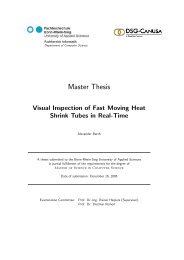Master Thesis - Hochschule Bonn-Rhein-Sieg
Master Thesis - Hochschule Bonn-Rhein-Sieg
Master Thesis - Hochschule Bonn-Rhein-Sieg
You also want an ePaper? Increase the reach of your titles
YUMPU automatically turns print PDFs into web optimized ePapers that Google loves.
2. Overview on human-robot <strong>Master</strong> <strong>Thesis</strong> Björn Ostermann page 17 of 126<br />
but stopping and waiting in a safe distance from the intrusion. Its advantage is its simpler realisation,<br />
which can be easier verified for freedom from errors.<br />
Both approaches can be combined. In this case, only the distance measurement needs to be approved<br />
for safety related work. The robot can not collide with any object due to path planning, if its approach<br />
on those objects is monitored. The functionality of the path planning algorithm is then only relevant<br />
for the performance of the process.<br />
2.3.2 Necessary algorithms and features<br />
To complete the given task several sub-goals had to be reached. The developed and applied solutions<br />
are described in chapter 4 and 5.<br />
There is no interface available from the manufacturer that allows the control of the chosen industrial<br />
robot with a C++ program. To remotely control the robot, only a set of XML (extended markup<br />
language) commands are available (see chapter 3.5 and chapter Fehler! Verweisquelle konnte nicht<br />
gefunden werden.) that have to be sent to the robot via TCP/IP. From those XML commands an own<br />
C++ interpreter had to be created. The XML commands are limited in their amount and can not be<br />
extended by the user. The robot needed to be controlled with relative and absolute positioning<br />
commands, but the relative positioning commands are not supported by the given XML commands.<br />
The solution to the relative control was achieved in the R&D 2 project [78]. In this master thesis the<br />
C++ library of the commands implemented in the R&D 2 was created (see source code on CD).<br />
The chosen 3D camera delivers a set of image data, containing the distance of objects and their<br />
reflectivity in the used near infrared spectrum. The image data delivered by the 3D camera can not be<br />
interpreted by a human observer. The values of reflectivity are usually very close to each other,<br />
resulting in a mostly black image when depicted in greyscale, and thus have to be enhanced, in order<br />
to depict an understandable image. The distance data need to be interpreted by the program as well, to<br />
show an understandable image.<br />
The optical analysis by a human observer is not only necessary for the development process of the<br />
final program. The illustration of the correctly working algorithm next to the robot can, especially at<br />
the introduction of this new technology, also enhance the operators trust in the developed concept.<br />
Algorithms for the reflection image as well as the distance image have been developed in previous<br />
work [78] and combined in this thesis with highlighting algorithms that show the robot, dynamic<br />
objects and the flexible border or the distance between robot and object, depending on the chosen<br />
algorithm.<br />
From the distance data, delivered by the 3D camera, the background of the empty workspace has to be<br />
acquired as a reference image, in order to be able to find intrusions later. Those intrusions have to be<br />
distinguished into robot and other objects. Problems in this area are mainly induced by the fluctuation<br />
noise, present in the acquired distance data. In order to achieve the desired goal, filters had to be tested<br />
and implemented, which reduce the fluctuation noise as much as possible.














